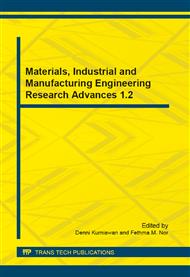[1]
V. Astaritaa, V. Giofre, G. Guido & A. Vitale, Investigating road safety issues through a microsimulation model. Procedia Social and Behavioral Sciences, 20 (2011) 226 – 235.
DOI: 10.1016/j.sbspro.2011.08.028
Google Scholar
[2]
P. Zhou., B.W. Ang, K.L. Poh, A mathematical programming approach to constructingcomposite indicators. E c o l o g i c a l e c o n o m i c s 62(2007) 291 – 297.
Google Scholar
[3]
Y. Shen, E. Hermans, D. Ruan, G. Wets, T. Brijs, K. Vanhoof, A generalized multiple layer data envelopment analysis model for hierarchical structure assessment: A case study in road safety performance evaluation. Expert Systems with Applications 38 (2011).
DOI: 10.1016/j.eswa.2011.05.073
Google Scholar
[4]
M. A. Akaateba, comparing road safety performance of selectedEU and African countries using a composite roadsafety performance index. Journal of natural sciences research 8 (2012).
Google Scholar
[5]
S. Bendak, K. Al-Saleh, The role of roadside advertising signs in distracting drivers. International Journal of Industrial Ergonomics 40(2010) 233 - 236.
DOI: 10.1016/j.ergon.2009.12.001
Google Scholar
[6]
Y. Zhang, D. B. Kaber, An empirical assessment of driver motivation and emotional states in perce-ived safety margins under varied driving conditions. Ergonomics56 (2013) 256 –267.
DOI: 10.1080/00140139.2012.739208
Google Scholar
[7]
D.A. Drew, C.C. Hayes, An Exploration of Decision Support for Drivers, Inside and Outside the Vehicle. Human Factors and Ergonomics in Manufacturing & Service Industries 22(2011) 420 – 436.
DOI: 10.1002/hfm.20378
Google Scholar
[8]
M.N. Lees, J. Cosman, J.D. Lee, S. P. Vecera, J.D. Dawson,M. Rizzo, Cross-modal warnings for orienting attention in older drivers with and withoutattention impairments. Applied Ergonomics 43(2012) 768 – 776.
DOI: 10.1016/j.apergo.2011.11.012
Google Scholar
[9]
M.G. Lenné, C.M. Rudin-Brown, J. Navarro, J. Edquist, M. Trotter, N. Tomasevic, Driver behaviour at rail level crossings: Responses to flashing lights, traffic signalsand stop signs in simulated rural driving. Applied Ergonomics 42 (2011).
DOI: 10.1016/j.apergo.2010.08.011
Google Scholar
[10]
Y. Zhang, E. Harris, M. Rogers, D. Kaber, J. Hummerb, W. Rasdorf, J. Hu, Driver distraction and performance effects of highway logo sign design. Applied Ergonomics 44 (2013) 472 – 479.
DOI: 10.1016/j.apergo.2012.10.009
Google Scholar
[11]
K. Al-Saleh, S. Bendak, Drivers' behaviour at roundabouts in Riyadh. International Journal of Injury Control and Safety Promotion (2012).
DOI: 10.1080/17457300.2011.581378
Google Scholar
[12]
K.A. Brookhuis, C.J.G. van Driel, T. Hof, B. V. Aremb, M. Hoedemaeker, Driving with a congestion assistant; mental workload and acceptance. Applied Ergonomics 40 (2008) 1019 – 1025.
DOI: 10.1016/j.apergo.2008.06.010
Google Scholar
[13]
M. Itoh, T. Horikome, T. Inagaki, Effectiveness and driver acceptance of a semi-autonomous forward obstacle collision avoidance system. Applied Ergonomics xxx(2013)1-8.
DOI: 10.1016/j.apergo.2013.01.006
Google Scholar
[14]
J. Edquist, T. Horberry, S. Hosking, I. Johnston, Effects of advertising billboards during simulated driving. Applied Ergonomics 42 (2011) 619 – 626.
DOI: 10.1016/j.apergo.2010.08.013
Google Scholar
[15]
D. Rodrick, V. Bhise, V. Jothi, Effects of Driver and Secondary Task Characteristics on Lane Change Test Performance. Wiley Periodicals Inc. 00(2012) 1 – 13.
DOI: 10.1002/hfm.20342
Google Scholar
[16]
E. Sunga, B. Min, S. Kim, C. Kim, Effects of oxygen concentrations on driver fatigueduring simulated driving. Applied Ergonomics 36(2005) 25 – 31.
DOI: 10.1016/j.apergo.2004.09.003
Google Scholar
[17]
E. Mitsopoulos-Rubens, M.J. Trotter, M.G. Lenné, Effects on driving performance of interacting with an in-vehicle music player: A comparison of three interface layout concepts for information presentation. Applied Ergonomics 42 (2011) 583 – 591.
DOI: 10.1016/j.apergo.2010.08.017
Google Scholar
[18]
D. Waard, M. van der Hulst, K. A. Brookhuis, Elderly and young drivers reaction to an in-car enforcement and tutoring system. Applied Ergonomics 30 (1999) 147 - 157.
DOI: 10.1016/s0003-6870(98)00002-7
Google Scholar
[19]
E. Hermans, T. Brijs, G. Wets, Developing a Theoretical Framework for Road Safety Performance Indicators and a Methodology for Creating a Performance Index. Universiteit Hasselt 010 (2008).
Google Scholar
[20]
N. Merat, A. H Jamson, F.C.H. Lai, Oliver Carsten, Highly Automated Driving Secondary Task Performance and Driver state. The Journal of Human Factors and Ergonomics Society. 54 (2012).
DOI: 10.1177/0018720812442087
Google Scholar
[21]
T.G.C. Griffin, M.S. Young, N. A Stanton, Investigating accident causation through information network modeling. Ergonomics 53: 2 (2010) 198 – 210.
DOI: 10.1080/00140130903125165
Google Scholar
[22]
G. Al-Haji, Road Safety Development Index (RSDI) Theory, Philosophy and Practice. PhD Thesis, Department of Science and Technology, Linkoping University.
Google Scholar
[23]
P. Tinga, J. Hwanga, C. Fungb, J. Doongc, M. Jenga, Rectification of legibility distance in a driving simulator. Applied Ergonomics 39 (2008) 379–384.
DOI: 10.1016/j.apergo.2007.08.002
Google Scholar
[24]
K. Hurts, L. S. Angell, & M. A. Perez, The Distracted Driver: Mechanisms, Models, and Measurement. Review of Human Factors and Ergonomics (2011).
DOI: 10.1177/1557234x11410387
Google Scholar
[25]
E. Hermans, T. Brijs, G. Wets, Elaborating an Index Methodology for Creating an Overall Road Safety Performance Score for a Set of Countries. 4TH IRTAD (2009).
Google Scholar
[26]
] G. Gallopin, A systems approach to sustainability and sustainable development. Sustainable Development and Human Settlements Division, (2003)1564 – 4189.
Google Scholar


